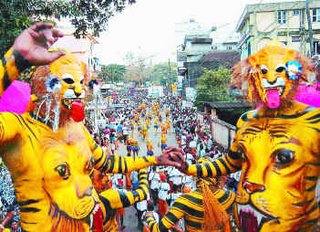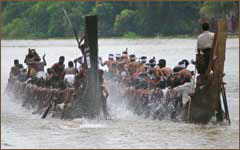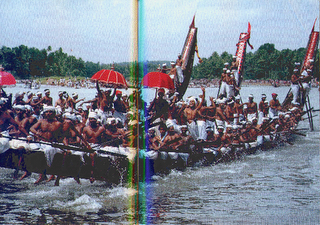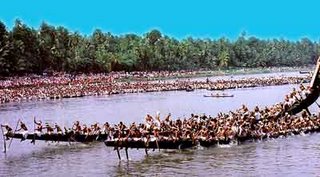This blog is your one-stop guide to the most renowned religious landmarks and captivating festivals across the globe. Embark on a virtual pilgrimage to discover the architectural wonders, sacred spaces, and cultural experiences that ignite faith and inspire millions.
Sunday, August 13, 2006
OTHER MAJOR BOAT RACES HELD IN KERALA
Pathanamthitta district
The two day Aranmula Boat Race is more a water fiesta than a competition, conducted during Onam. The event is a re-enacting of the legend involving a devout Brahmin who made a votive offering of feeding one pilgrim a day. One day Sree Krishna himself appeared to him and the overjoyed Brahmin vowed to offer 51 measures of rice and all the provision for the thiruvona sadya (the sumptuous Onam feast) at the Aranmula Parthasarathy* Temple. Once, the thiruvonachilavu thoni (the boat carrying the offerings) was intercepted by rivals from another village, but the Brahmin's own villagers came to the rescue on snake boats. From then on the offering was carried by a fleet of palliyodam - about 48 of them representing the nearby backwater villages. (A palliyodam is a large, luxurious snake boat used by gods and royalty.)
Today, only 26 snake boats participate in the event which is marked by a colourful water carnival - an imposing effigy of Sree Krishna is taken out in procession on the lake with children dressed as nymphs and princesses. On the second day, snake boats decorated with silken parasols, carrying helmsmen, oarsmen and singers assemble near the temple early in the morning and then move away in pairs, creating a magnificent pageant. The boat race proper is held in the afternoon.
* Parthasarathy is Sree Krishna
in his role as Prince Arjuna's charioteer, in the epic Mahabharatha.
Champakulam Moolam Boat Race
Champakulam, Alappuzha
The oldest and most popular snake boat race in Kerala, this event is closely connected to the Sree Krishna Temple at Ambalappuzha. The race is held on the Champakulam Lake on the moolam day of the Malayalam month midhunam, the day of the installation of the deity at the Temple.
Legends say that Maharaja Devanarayana of Chempakasseri, as instructed by the royal priest, built a temple at Ambalappuzha. But just before the installation of the deity he was informed that the idol was not auspicious. The king was disturbed, but his minister suggested an inspired solution. To bring down the beautiful idol of Sree Krishna - presented to Arjuna by the Lord himself, from the Karikulam temple in Kurichi. The minister with a few others went to Kurichi, met the authorities there and returned with the idol. On the way back they stopped at Champakulam to spent the night and perform a pooja. The next morning boats from the entire region assembled to escort the idol in a colourful, ceremonial procession through the lake to the Temple.
Years later the pageant is still re-enacted with the same enthusiasm. An exotic procession of water floats, boats decorated with colourful parasols and performing arts greets the spectator before the race. The race proper is held in various stages for various categories of boats.
Payippad Jalotsavam
Alappuzha
The three day annual fiesta on the Payippad Lake, 35 km from Alappuzha, commemorates the installation of the deity at the Subramanya Swamy Temple, Haripad. The story is that the people of the village decided to build a temple with Sree Ayyappa as the presiding deity. After the temple was ready, they had a vision directing them to a whirlpool in Kayamkulam Lake where they would find the idol of Sree Subramanya which was to be installed at the temple. Accordingly, the elders of the village with divers and swimmers rowed to the spot and found the idol which was escorted back ceremoniously by devotees from the entire region in colourfully
Other boat races held during Onam (August/September):
ATDC Boat Race, Alappuzha
Rajiv Gandhi Boat Race, Pulinkunnu
Neerettupuram Boat Race
Kumarakom Boat Race
Karuvatta Boat Race
Kavanattinkara Boat Race,
Kumarakom Arpookara Vanitha Jalamela,
Kottayam Mahatma Boat Race, Mannar
Thazhathangadi Boat Race,Kottayam
Kottapuram Boat Race,
Kodungallur and Kumaranasan Smaraka Jalotsavam, Pallana.
The Indira Gandhi Boat Race is held on the Ernakulam Lake during the Cochin Carnival in the last week of December.
onam dances--Kaikottikali
Kaikottikali or Thiruvathirakali
Kaikottikali, also known as thiruvathirakali, is a very popular, graceful and symmetric group-dance of the women of Kerala often performed during festive seasons like Thiruvathira and Onam.
The actor recites stories from the epics (based on Sanskrit text) interpreting them in Malayalam, enlivening his narration with Thandava dance rhythms and also gestures and bodily postures which are clearly derived from Natya Sastra.
It is a simple and gentle dance with the lasya element predominating, even though the thandava part is also brought in occasionally, when men also participate as seen in some parts of the Malabar area. Typically dressed in Kerala style with mandu and neriyathu and the hairbun bedecked with jasmine garlands the women dance in gay abandon, singing melodious Thiruvathira songs which are well-reputed for their literary flourish. One of the performers sing the first line of a song while the rest repeat it in chorus, clapping their hands in unison. Moving in a circle, clockwise and at time anticlockwise, at every step they gracefully bend sideways, the arms coming together in beautiful gestures, upwards and downwards and to either side, in order to clap
Onam festival of kerala --Thumbi Thullal
Thumbi Thullal
Wearing their best sarees, stunning jewelery and fragrant gajras, a group of women sit in the formation of circle to play Thumbi Thullal. In the centre of the circle sits the main performer.
Lead singer initiates a song in her melodious voice by singing the first couplet which is taken up by other women. The sequence continues song after song with the lead singer initiating the couplet every time followed by a chorus from other women. Joyful clap dance also goes on in rhythm with the singing.
It is a colorful spectacle to watch women in their carefree mood. The event continues amidst jeers and laughter till the day comes to its end.
Onam festival of kerala--Pulikali
Pulikali is a colorful recreational folk art from the state of Kerala. It is performed by trained artists to entertain people on the occasion of Onam.
Pulikali, also known as Kaduvaakali, is a 200 year old art, carefully preserved by the artists of the state. Literal meaning of Pulikali is the 'play of the tigers' hence the performance revolve around the theme of tiger hunting. The folk art is mainly practiced in Thrissur (Trichur) and Palghat districts of Kerala. Best place to watch the show is Swaraj Ground at Thrissur on the fourth day of Onam, where Pulikali troupes from all over the district assemble to display their skills.


The Appearance
Striking feature of this folk art is the colorful appearance of the performers. To get the semblance of a tiger artists paint themselves in bright yellow with patterns of black and red. A tiger mask on the face completes the get up.
It is a painstaking job and artists spend a whole night prior to the performance day on their make-up. Patience of artists must be appreciated, as most paints contain toxic chemicals which create a burning sensation when applied on newly shaved bodies.

The Play
It is a wonderful sight to see humans in the guise of tigers roaming in the streets. Children, specifically take great delight in their performance as the entertainers dance, pounce and walk like a tiger. Scenes of tiger hunting goats and tiger being hunted by a human beings are also beautifully depicted by them. Beat for the dance movement is provided by percussion instruments like 'udukku' and 'thakil'. The Swaraj Round in Thrissur district is the venue of a grand Pulikali on the fourth Onam day. On this day Pulikali troups from different parts of the district come here to perform.
Onam festival of kerala--Kummatti kali
Kummatti kali - The Mask Dance
Most interesting facet of Kummattikali is a peculiar way in which Kummati performers clad themselves. They don a heavily painted colourful wooden mask depicting faces of Krishna, Narada, Kiratha, Darika or hunters. These masks are usually made out of saprophyte, jack fruit tree, Alstonia Scholaris, Hog Plum tree or the Coral tree.
Dancers wear skirts woven out of plaited grass. Some performers cover their whole body with bunches of grass for a more bushy appearance. The semblance is made more joyful with the 'talla' attached externally to the mask giving the appearance of a toothless open mouth. Dancers also hold and manipulate long sticks of residuary agricultural produce called 'Kummattikali', it is from this that the dance derives its name. Their dance is related to Shaiva myth. 'Thamma' (an old woman) walks in front with the help of a stick. Thamma is symbolic of mother of every being and everything.
Rhythm for the dance movements is provided by vibrating the string of a bow like instrument called onavillu. Arecanut wood is used to make the bow and the strings are beaten with a narrow bamboo stick.
Kummatti dancers are a sight to watch as they move around from house to house collecting jaggery, rice, or small amounts of cash. Onlookers, specially children take great delight in their performance.
Themes of Kummattikali are mostly taken from the stories of Ramayana, Darika Vadham, the story of Shiva and folk tales like Manjan Nayare Pattu.
It may be noted that folk art of Kerala can be classified into two broad categories - ritualistic and non-ritualistic. Ritualistic can be further divided into - Devotional, performed to please a particular god and goddess and Magical Art Forms. Theyyam, Thira, Poothamthira, Kanyarkali, Kummattikali, etc. are some of devotional art forms.
Kummatti dances are more rampant in Trichur District, during Onam. Pristine or original form of Kummattikali can be seen in the Bhadrakali temple in Palghat district.





